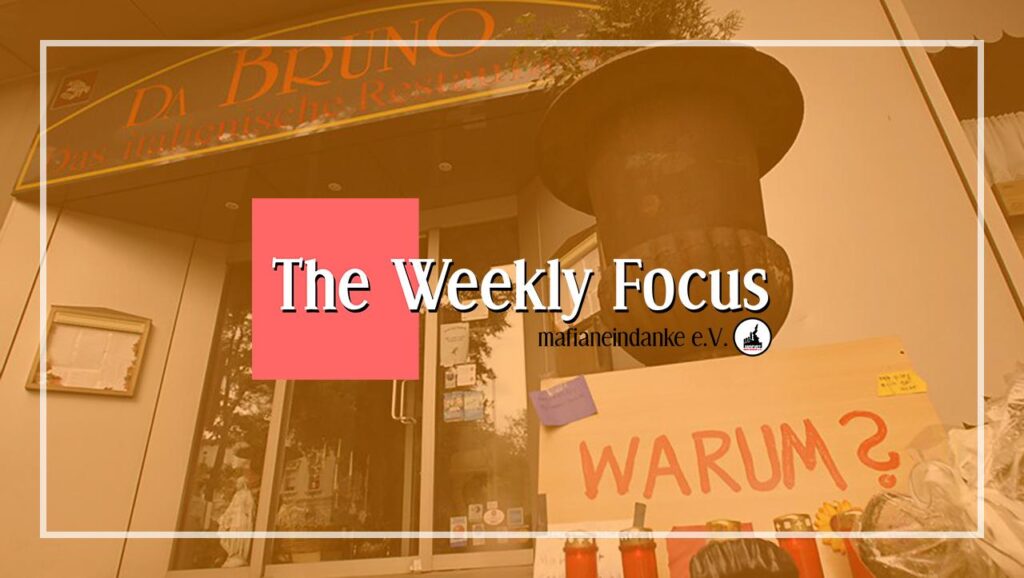Exactly 12 years ago, on 15th August 2007, the Duisburg massacre shook Germany and turned the spotlight on the ‘ndrangheta, a criminal organization which, until then, had been particularly silent outside its own territories of origin.

On the night of August 15, 2007, six men between the ages of 16 and 39 lost their lives, all originating in the province of Reggio Calabria, except for Tommaso Venturi, originally from Corigliano Calabro, who was turning 18 years old on that day. The victims were hit by two killers at the exit of the Italian restaurant ”Da Bruno”, where they had spent the evening to celebrate the birthday of the friend. The renowned restaurant in the town in North Rhine-Westphalia was already known to the Italian and German police as a place of money laundering. The killers, to ensure the success of the ambush, cooled each of their victims with a final blow to the head. The burnt image of St. Michael the Archangel was found in the clothes of the celebrant, a sign of a possible affiliation to the clan celebrated just that evening.
The Duisburg massacre, also known as the Ferragosto massacre, is the last episode of the bloody feud of San Luca, which began in 1991 and which saw the Nirta-Strangio oppose the Pelle-Vottari-Romeo. The feud, which apparently began for futile reasons, has seen a series of settlements of accounts, often perpetrated in days significant from the symbolic and religious point of view. The aim of hitting one’s enemies during the festivities is to make the pain of the victim’s relatives even deeper, so that one day of celebration becomes a day of mourning forever.
According to this scheme, the clash between the warring factions was re-ignited by the murder of Maria Strangio, wife of the boss Giovanni Nirta, which took place in San Luca on 25 December 2006, in an ambush whose main objective was the Calabrian boss. The weapons used on that occasion came from Duisburg.
It is in this framework that the decision of the Nirta-Strangio to attack their rivals even abroad, in Germany, more than 2000 km away from San Luca (RC), is to be traced back, running the enormous risk of attracting the attention of the forces of law and order and public opinion to themselves, unexpectedly defeating the strategy of camouflage which had had been enormously successful, allowing the ‘ndrangheta to take root and reproduce its own organizational model also abroad. Behind the attack of Duisburg, however, there was not only a thirst for revenge. There was also the will to reaffirm one’s own criminal power and to obtain control of the illicit traffics in the region. Drug trafficking generated enormous profits and the region of North Rhine-Westphalia was a strategic junction, given its proximity to the border with Holland, where drug shipments from South America arrived at its ports. Over the years, the Calabrian clans have carried out a real territorial division of the German Land. The Nirta-Strangio, for example, control the Kaarst area, while the Pelle-Vottari-Romeo extend their dominion over the Duisburg area. In this case, the Rhine River separates the respective areas of influence of the rival clans.
Germany is the European country where the ‘ndrangheta has managed to penetrate more effectively, despite the apparent cultural incompatibility. The massacre of Ferragosto showed all the ease of action and confidence of the criminal organization of Calabrian origin that is, one step at a time, colonizing the German territory. This episode, however, has revealed to the whole world the ferocious and criminal nature of the ‘ndrangheta. The excessive exposure has undoubtedly had negative effects for the organization, at least in the immediate future.
The German public opinion, in fact, has finally realized its existence. The Italian and German investigative authorities have developed a fruitful relationship of collaboration which has led, in the period following the massacre, to the capture and arrest of numerous affiliates involved in the feud of San Luca.
On the one hand, there were already several signs that indicated a strong penetration of the ‘ndrangheta in Germany. On the other hand, however, they were long underestimated and only the shock caused by the Duisburg massacre opened the eyes of public opinion and institutions. However, the initial astonishment soon made room for ‘removal’ by German society. The image of Duisburg – and of the whole of Germany – could not be polluted by the presence of the mafia. The negative image had to be erased and the episode forgotten. Once the trial for the facts of Duisburg was transferred to Italy, for Germany the case was to be considered closed. The matter was considered a business between Calabrians, a problem of Italy. This removal greatly facilitated the ‘ndrangheta, who returned to silence and became peaceful internally. Too much exposure had been a mistake and it was now necessary to give priority to business rather than internal disputes. What is striking about the ‘ndrangheta and which can also be seen by analysing the facts of Duisburg is its dual nature: on the one hand, it is a modern organisation, it takes advantage of the opportunities offered by globalization and is oriented towards profit; on the other hand, it maintains its own ancestral customs, its ties with the motherland and its rituals.
In addition to the removal by society, the ‘ndrangheta can also exploit to its own advantage the shortcomings of the German legislation, which is very weak in terms of the fight against the mafias. In Germany, for example, there is no crime of mafia association, as provided for within the Italian legal system (416 bis). The German legislation, in fact, specifies only the criminal association, through Article 129 of the Criminal Code. There is also a lack of legislation on the seizure and confiscation of property. Following the Second World War, in stark contrast to the totalitarian regime of the past, Germany adopted legislation that was strongly geared to protecting the individual. For this reason, everything that concerns the confiscation of personal property and property is very difficult to implement. German law, while in some cases providing for the possibility of seizure and confiscation of property, does not allow this to happen in a preventive manner and provides that the burden of proof is on the prosecution. All this represents an enormous limitation in the fight against the mafias. If there were greater awareness of the seriousness of the risk faced by society, these obstacles could be overcome.
The ‘ndrangheta is aware of these limits, knows that it is unlikely that Germany will adopt more effective measures in matters of confiscation of goods and therefore transforms the country into one of the main centers in which to launder the proceeds of illicit trafficking.
It is also difficult to talk about the mafia in Germany. Journalists often find themselves fighting against legislation which, in view of the extreme protection of the individual mentioned above, does not allow them to write freely about the subject. Journalists are sometimes silenced through censorship. This is the case, for example, of Petra Reski, a German investigative journalist who, after having received several complaints, has been blackened by the authorities with her book “Santa Mafia” (original title: Mafia. Von Paten, Pizzerien und falschen Priestern). Given the absence of the crime of mafia association in Germany, it is not possible to attribute links with the mafia to persons who have not already been convicted in Italy for 416 bis. There is also the right to social rehabilitation, so you cannot appoint in full (name and surname) convicted persons who have already served their sentence. Their history can be told, but people can only be named using abbreviations. The mafia in Germany can therefore make use of the lawsuit, which is much more convenient and less risky than threats and intimidation, with ample chance of success. To be the victim of these dynamics was also a documentary broadcast by the television station MDR, which focused on the economic activities of ‘ndrangheta in Erfurt, a town in Turinga that represents a real Eden for the money laundering by the criminal organization of Calabria. After having suffered a series of complaints, the documentary was also censored. Life for investigative journalists in Germany is therefore particularly difficult, there are disincentives to write about the mafia and often the publishers themselves are not willing to run the risk of publishing news on the subject to avoid running into legal trouble.
Twelve years after the events in Duisburg, the situation regarding the fight against the mafias in Germany is not the rosiest. There are many issues on which we should work and insist. First, there is a need for greater awareness of the danger of the mafia phenomenon and the risks it represents for society. Secondly, despite the presence of virtuous experiences dedicated to raising awareness on the subject, there is a need to build larger networks, which also extend to places – such as East Germany – where now there are no active realities on the anti-mafia front. There is also a need to offer more free information on the subject and of greater quality, where the fight against stereotypes of the mafias is another important issue. Finally, as we have seen in the section on this subject, it is essential to adopt legislative instruments to combat this phenomenon, which are appropriate to the scale of the phenomenon we intend to combat.

